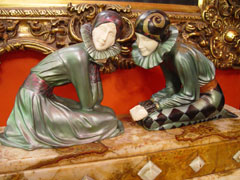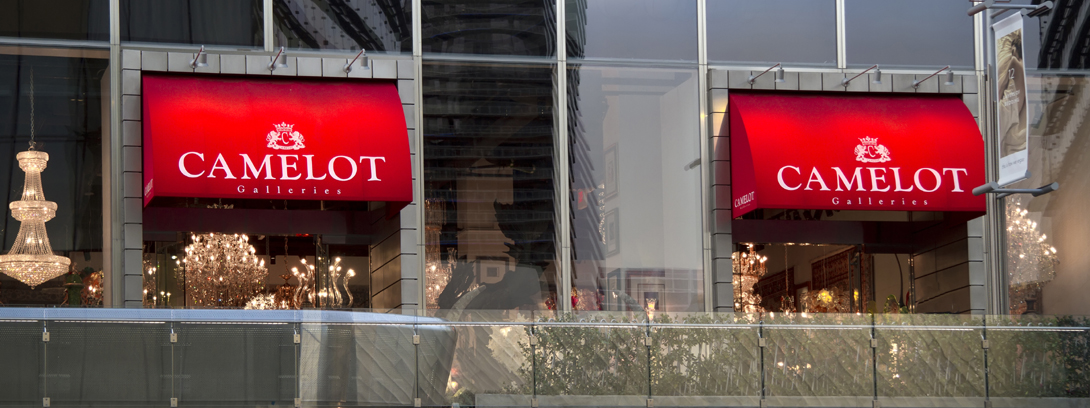 During the years when Art Deco as a style was in fashion the term Art Deco was not known. Modernistic or Style Moderne was used. The term was coined in the 60’s by Bevis Hillier, a British art critic and historian. The name Art Deco was derived from the 1925 Exposition Internationale des Arts Decoratifs Industriels et Modernes, held in Paris.
During the years when Art Deco as a style was in fashion the term Art Deco was not known. Modernistic or Style Moderne was used. The term was coined in the 60’s by Bevis Hillier, a British art critic and historian. The name Art Deco was derived from the 1925 Exposition Internationale des Arts Decoratifs Industriels et Modernes, held in Paris.
One can understand why it was shortened to a much more pronounceable nomenclature. By the 1970’s the term was widely accepted and is still in use today. Art Deco is used to refer to a mix of styles from the 1920’s and 1930’s, but it’s meaning is continually evolving.
Demetre H. Chiparus was born in Romania in 1886 and then traveled to Paris before World War I to become more involved with his artwork. He attended school in Italy and at the Ecole des Beaux Arts in Paris, and he exhibited at the Salon in 1914. Chiparus was particularly adept in the technique of chryselephantine, the combination of bronze and ivory to produce dramatic, stylized sculpture. He produced most of his renowned works between 1914 and 1933. Paris was an exciting place in the years leading up to World War II, when Art Deco style and swinging good times were in vogue just as in the United States. His later works in the 1920’s were influenced by his interest in Egypt, after the excavation of the Pharoah Tutankhmen’s tomb. Some of his most exciting works are dancers taken from the Russian Ballet, French theatre, and early motion pictures. Dancers were captured in movement, dressed in high Art Deco style and long and lean in appearance.
Demetre Chiparus worked primarily with the Etling Foundry in Paris, and he died in Pairs in 1947. Period Chiparus work almost always has a foundry name and D. H. Chiparus signature etched in the marble, and usually very hard to find and see. There are many reproduction on the market, and signatures alone mean nothing. Look closely at areas like the fingers; authentic period Chiparus sculptures typically have long, slim fingers with such detail that you can clearly make out each individual fingernail. Examine all the detail, the age of the marble, age lines in the ivory, etc. and consult a professional to protect yourself from unscrupulous dealers and individuals.
Bruno Zach worked between the years of 1918 and 1935, reveling in the spirit of Art Deco. Although he executed some graceful moving statues, this Berlin based sculptor devoted most of his energy and talents to the exotic. Zach loved to render his world of exotic nightlife in his work, especially the prostitues with whom he loved to socialize. In fact, one prostitue with whom Zach was in love refused to marry him, leading to the work “Hearts” which you can view in the museum gallery.
Art Deco Sculptors featured by our Galleries include . . .
Descomps, Joseph (Joe) –
1869 – 1950, French sculptor, exhibited many works at the Salon, Paris.
Gilbert, Alfred –
born London 1854. Most famous work, Eros in London’s Trafalgar Square. Died 1934.
Guiraud Riviere
Maurice Giraud Riviere, born in Toulouse France. became a member of the Salon where he exhibited his works during the 1920s and 30s.
Carl Kauba
Austrian artist Carl Kauba was born in Vienna 1865, and died in 1922.
Le Faguays, Pierre
Pierre Le Faguays was born in Nantes, France and became famous for the originality he gave his dancers, many of which were inspired by the statues of Tanagra. He gained a medal of honour for his work in 1927. He was a best friend of Max Le Verrier and the Le Verrier foundry produced many of his pieces. He used 2 pseudonyms as well as his own name and they were Fayral and Guerbe. Which were the family names of his Mother and his Wife. He was a leading sculptor and his work is frequently praised for its high quality and attention to anatomical accuracy. He also produced designs for Goldscheider in Paris under the “La Stele” label. He worked in several mediums including ivory, bronze, spelter, stone, wood, alabaster and ceramics. He studied with his friend Max Le Verrier.
Moreau, August worked 1860 – 1910, prolific nouveau spelter and bronze sculptor.
Poertzel, Prof. Otto –
born 1876 in Scheibe im Thüringer Wald in Germany. Studied at the Czech Academy for porcelain at Prof. R. Möller, before becoming a sculptor in Coburg for 8 years. Afterwards, he studied at the Art Academy in Munich under Prof. E. Kurz & Adolf von Hildebrandt. Participated in numerous international art exhibitions, e.g. St. Louis World’s Fair (1904) & the International Art Exhibition in Brussels (1910). Worked 1910-1930 and produced many of the larger monuments and some of his earlier works can be found in the German Royal Courts, and a few were purchased by the King of Bulgaria. He specialised in female busts (during 1920s & 1930s Poertzel was making busts of the aristocracy in Europe). Died in 1963. Poertzel and Ferdinand Preiss shared a studio in Berlin and at one time it was thought that the two were the same person as their work is very similar, and often confused.
Ferdinand Preiss (1882 – 1943)
Johann Philipp Ferdinand Preiss was born in Erbach (Oderwald) in Germany on the 13th of February 1882. His father owned and ran the local Preiss Hotel, while his mother came from a traditional ivory carving family. When Ferdinand was fifteen years old his father died, the Hotel was sold, and the six children dispersed among relatives and friends. Ferdinand Preiss moved in with the family of Philipp Willmann (1846 – 1910), a master ivory carver and teacher with whom he went through a thorough apprenticeship, emerging as one of the finest ivory carvers of his generation, and he remained in Willmann’s studio until Easter 1901. His movements over the next few years are unknown, but by 1905 he appears to have been working for Carl Haebler in Baden-Baden after a period in Milan; AT the Haebler works he met a number of young carvers from Erbach. One co-worker, Arthur Kassler himself a Berliner went into partnership with him and they moved to Berlin, where they opened a small workshop in which they worked as turners and carvers in ivory. The firm was called Preiss and Kassler. In 1907 Preiss married Margartehe Emma Clara Hilme. I 1910 the firm took on two new carvers. Louis Kuchler and Ludwig Walther and the firm’s name was shortened to PK. The earliest compositional figure by Preiss is a stauette of Phryne carved from three different woods in his son’s collection. His early designs were classically inspired Grecian figures certainly part of the tradition received from Willmann, but also part of the taste for copies from the Antique which were then very popular. Phryne reappeared in bronze and ivory with an onyx or marble base in the company of Aphrodite, Iphigenia, Pomona and others. Another early design was a figure of Carmen. These early figures had the bronze section of the figure cast at the Akt Ges Gladenbeck in Berlin. Robert Kionsek from the Gladdenbeck foundry joined PK and firm gradually expanded, having about half a dozen workers when war broke out in 1914. When the firm restarted in 1920 after the war, Preiss designed a wide variety of figures; exquisitely graceful ivory nudes, bronze and ivory bathers, dancers, couples children and historical figures. Preiss figures are the epitome of grace and elegance, the faces pretty, but with character; the costumes colorful but restrained. His series of Olympians have often been equated with the Nazi ideal by the ignorant. In fact these men and women playing tennis, throwing a javelin, holding an oar, playing golf are just health, outdoors types all date from the nineteen-twenties years before Hitler acquired any power. The Olympic Games that inspired most of these were in France where the Salons had separate and very active sections dealing with the Art of Sport. Preiss most loyal following was in England, and he showed his appreciation by carving a figure of the young Queen Elizabeth (now Elizabeth II). His skill at ivory carving is exemplified in his figure of St. George and the Dragon as well as in his ivory nudes. Preiss died in 1943 of a brain tumor. The PK firm did not survive.

































